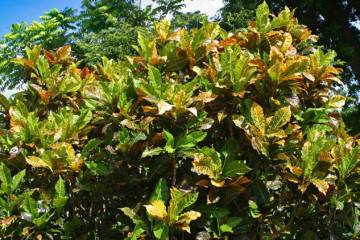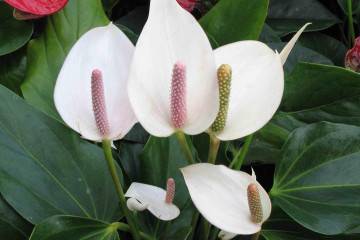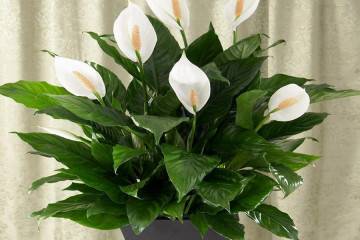Spathiphyllum - types of flower, description of what they look like
Content:
- What spathiphyllums look like
- Description of common species and varieties
- Spathiphyllum profusely flowering
- Spathiphyllum is pleasant
- Spathiphyllum cannoli
- Spathiphyllum spoon-shaped
- Wallis Spathiphyllum
- Spathiphyllum Lauretta
- Spathiphyllum Mauna Loa
- Spathiphyllum Bellini
- Spathiphyllum Chopin
- Spathiphyllum Domino
- Spathiphyllum Gemini
- Spathiphyllum Alfetta
- Spathiphyllum Vivaldi
- Spathiphyllum Silver Cupido
- Spathiphyllum Angel Baby
- Spathiphyllum Picasso
- Spathiphyllum Cupido
- Spathiphyllum Alana
- Spathiphyllum red
- Spathiphyllum is poisonous or not
- Possible problems in growing spathiphyllum
"Women's happiness" - this name was given to a flower from tropical forests, which is loved by flower growers. They have long noticed that spathiphyllum is actively growing only in that house where love and harmony reign. Its peculiarity is the variety of species, of which there are about 40. They can differ noticeably in appearance, so it is worth choosing based on the parameters of the room and its design.
What spathiphyllums look like
Spathiphyllum was discovered in the 19th century by botanist Gustav Wallis in Colombia, where it is still found in the wild today. Its typical habitats are wetlands: the shores of lakes, rivers and undergrowth of tropical forests. The flower has been popular as a houseplant for a long time, but work on the selection of spathiphyllum to obtain new varieties began only in the 50-60s of the 20th century.
Spathiphyllum is widespread, its range is ruptured - the plant is found in Central and South America, as well as on the islands of the Old World. Like many tropical flowers, none of its species shed their leaves. All varieties of spathiphyllum are perennial evergreens.
They have a characteristic structure: a short root, no stem and a white flower. The shape of the leaves is oval, the vein in the middle is pronounced, from which the processes extend over the entire leaf area. The white cover of the petals is longer than the cob, the seeds are smooth, curved in shape.
Description of common species and varieties
Spathiphyllum, the species of which form a huge group, is a houseplant - it should not be planted outdoors in the garden.
Despite the characteristic structure, the varieties of this flower are quite distinguishable. To do this, you need to pay attention to several parameters:
- leaf color;
- foliage size;
- flower size;
- shade of petals;
- plant height.
In care, all varieties of spaliphyllum are unpretentious, so you need to choose one that fits well into the design of the room and will correspond to the scale of the green corner.
Spathiphyllum abundantly flowering
Spathiphyllum Floribundum is one of the most popular species and can be called classic.
Light green leaves (in young shoots they are brighter), the petiole is thin, the vein in the center is clearly visible. The length of the foliage is 20 cm, the petiole is 10 cm, the peduncles are high, and the perianths are not large. Suitable for decorating a windowsill, as it blooms all year round.
Spathiphyllum is pleasant
Differs in large leaves, the shape of which is rather elliptical than oblong. The Latin name is Spathiphyllum Blandum.
The length of the petiole and leaves reaches 30 cm, the bract is 10 cm lower. Blooms periodically, with good care - constantly.
Spathiphyllum cannoli
This plant, also known as Spathiphyllum Cannifolium, differs from other varieties in its elongated leaf shape and dense structure.
The white blanket can be called a giant, its length is at least 15-22 cm. Distinctive features: the inflorescences have a smell, and the cob is smooth, not rough.In the wild, it grows in South America and on the island of Trinidad.
Spathiphyllum spoon-shaped
This variety has such an unusual name because of the shape of the white bedspread: it retains its curvature throughout the entire growth of the plant.
It was first discovered in Brazil, it can be called a giant spathiphyllum: it grows up to 1 meter, the leaf width can reach 15 cm, and the length is almost half a meter! The petioles may even be 70 cm long.
Wallis Spathiphyllum
Spathiphyllum Wallisii Regel is the most common species.
Compact parameters - height 35 cm, length of leaves about 22-24 cm and inflorescences with a radius of up to 3 cm make it an excellent tenant of a flower arrangement. At the same time, the leaves are elongated, on flexible petioles they eventually tilt to the ground.
This species blooms periodically - from April to September, the white blanket becomes rich green with the growth of the cob. The ear also gradually changes color from cream to green. In terms of the usefulness of air purification, it is on the same line with the Hedera Helix new ivy.
Breeders have done a great job of obtaining new types of spathiphyllum, which are now available on a par with the original varieties. The results have been excellent, and certain varieties have become very popular.
Spathiphyllum Lauretta
Derived in 2001 from the Wallis variety, Lauretta new spathiphyllum has long stems and large leaves. Also, the royal spathiphyllum is distinguished by its large size.
Spathiphyllum Mauna Loa
A miniature showy plant, Mauna Loa has elliptical bracts that completely cover the creamy ear. The foliage has a bright green color, the petioles supporting it are up to 10 cm long. The homeland of this variety is Colombia.
Spathiphyllum Bellini
The classic type of plant distinguishes it from others: a lush erect crown and graceful medium-sized inflorescences. It is easy to take care of it, it is convenient to keep it in offices or on a small windowsill.
Spathiphyllum Chopin
A practical solution for the office - the Chopin variety, despite its miniature size, does an excellent job of freshening the air and decorating the interior.
Its foliage is deep green in color and has pointed ends, and has cobs and white bedspreads on its long petioles (relative to the leaves). Until the evening, this flower exudes a pleasant aroma, which makes it even more attractive to buy.
Spathiphyllum Domino
Spathiphyllum Domino one is a rare find for florists, which must be cherished and put in a prominent place. This is a rare variety, it is distinguished by an amazing kind of foliage - an emerald hue is replete with white spots.
Its height barely reaches 35-40 cm, prefers certain growing conditions: partial shade, lack of direct rays, drafts and abundant watering. The aroma can be felt until noon, after lunch, its intensity decreases.
Spathiphyllum Gemini
The bract has pointed leaf tips and a variegated color - this variety is rare.
Spathiphyllum Alfetta
Unpretentious type, Alfetta is perfect for decorating a room in a simple style.
Oval, pointed leaves and long flowering give it a special charm. Household specimens need to be watered regularly, this variety loves moisture.
Spathiphyllum Vivaldi
A spreading crown that grows on a short stem distinguishes this variety from others.The leaves are deep green with a vein in the middle, the tips of the plate hang down. The inflorescence is creamy, the flowers are medium-sized.
Spathiphyllum Silver Cupido
A truly tropical look, it has bright lettuce foliage and large graceful inflorescences. Will refresh any interior. Spathiphyllum Silver Cupido is unpretentious in care. This species is sometimes also referred to as the Pearl Cupido.
Spathiphyllum Angel Baby
It is not for nothing that the miniature spathiphyllum Angel Baby is called that way: it is easy to recognize by its narrow light leaves with rare dark stripes. A perennial plant with elongated white petals.
Spathiphyllum Picasso
Like Dominoes, this species is a successful breeder. It is even less common, it is very different from other varieties - the white color of the bedspread extends to the leaves, occupying a significant area of them. Even the perianth shows a creamy streak!
Picasso does not require special care, only needs a uniform dim light and regular watering.
Spathiphyllum Cupido
The variety, bred in the Netherlands, is the embodiment of laconicism and minimalism: neatly shaped pointed leaves, medium-sized white blankets on long petioles.
Cupido does not require painstaking care, it will decorate any interior without taking up a lot of space.
Spathiphyllum Alana
A spectacular Alana plant with sprawling but upright foliage. Having a height of half a meter, it preserves the slenderness of the crown. The leaves are glossy and dark green, have a clear vein and a wide bracts.
Spathiphyllum red
An inexperienced grower can easily be impressed with spathiphyllum with scarlet bracts. But the suspicion of artificial interference with an unusual shade is groundless.
The fact is that there is a flower similar to spathiphyllum - this is anthurium. Thanks to the efforts of botanists, they can have pink, red and burgundy bedspreads.
Spathiphyllum is poisonous or not
It belongs to the Aroid family, therefore it is considered conditionally poisonous.
Its shoots contain calcium oxalates and oxalic acid that are dangerous to humans, which, if ingested, irritate the mucous membranes and skin. Eating shoots can be dangerous. Therefore, in the presence of very young children, it is imperative to make sure that they do not inadvertently eat shoots. Accidental use may cause stomach pain, indigestion. In rare cases, an allergic reaction occurs.
Possible problems in growing spathiphyllum
Before rushing to treat a plant that has suddenly lost its beauty, it is worth analyzing the care of it. Often, it is the florist's mistakes that lead to the fact that the flower is attacked by diseases and pests.
From a young plant, one should not expect rapid flowering, only a mature plant, whose roots have completely occupied the pot, is capable of this. Other common problems include:
- Yellowed leaves - insufficient watering and old soil.
- If the tips have become yellow, the reason must be sought in the excessive hardness of the water.
- Drying shoots and their loss - low air humidity, can be solved by placing a tray with water next to it. Spraying is useless!
- Blackened tips of leaves indicate problems with watering. By varying the irrigation patterns, you can recognize your mistakes.
As for pests, the most dangerous are spider mites and aphids that surround the plant throughout the foliage. To defeat the first one, you need to wash the plant in a soapy solution - the pest will not endure such a procedure. Aphids are more tenacious, you will have to act immediately and repeatedly (possibly). It is necessary to treat the flower with a solution of nicotine sulfate (1 g per 1 liter of water).If the scabbard attacked, treat the spathiphyllum with a tobacco-soap solution, then only with soapy water. The finishing touch is insecticide treatment with a suitable composition.
Spathiphyllum is a bright and unusual plant that can transform the interior even alone. It does not require special conditions, it is enough to water it regularly and keep it away from sunlight. A huge variety of varieties allows you to choose an option that suits the size and shade of the leaves.






















